Many want to make their plot or garden in unique and unique. And for this you need a variety of exotic plants. One of these is the heather, a favorite plant in Europe and such a dicker in Russia.
But his beauty is able to eclipse many cultures. Gentle shades of pink, white, blue, purple harmonious fit into any landscape design. And what a charming fragrance exudes this flower, just not convey words. Such a honeycomb is a great solution for the decoration of the garden or the plot. Of course, to obtain the final result, it is necessary to put it properly and grow this plant, but the works are worth it.
In this article, we will consider the features and description of heather, learn about the most popular and common types and varieties of this exotic shrub. As well as define all the main nuances of agrotechnics of growing plants heather.
General characteristic of Veska
In nature, there is only one type of this plant - the heather ordinary, which is the only representative of the heather's family. This is an evergreen perennial plant having a shape of a small shrub. Heather is a very common plant, its varieties are found almost all over the globe. Delicate heralds can be seen in Europe, along the Atlantic coast of North America, in some areas of Africa and Greenland, as well as in Asia. On the territory of Russia, this gentle flower is found in the European part and in Siberia.
The natural aril of the habitat of this plant is the territories of tundra and coniferous forests, as well as the slopes of mountains and wasteland. Very often, the wide thickets of heather are found on fires. Such a cluster of the shrubs of herasska is customary to be called a barney or drovel.
There is a very interesting Scottish legend about the origin of heather. According to her, the heather became the only plant, which agreed to the request of God to grow on the poor lands, on the wasteland and rocky slopes of the mountains, which from all sides are blocked by the winds. For this heather was endowed with unpretentiousness, good endurance, gentle shades of colors and a charming aroma.
Heath description:
- Evergreen perennial plant growing in the form of a small, highly branched shrub. Sometimes there are sharpening forms of this plant.
- Heather height can reach 30-70 cm in height, sometimes in nature can reach a meter height.
- Herack flower grows very slowly - only 1.5-2 cm per year.
- Hungry stems thick sleeping with small leaflets of a triangular shape. In size, they barely reach 2.5 cm long. Slightly rolled into the tube.
- The leaves are located on stems in 4 rows, fully covering their surface. Flower leaves can be different. Based on this, all varieties of heather are divided into several groups of foliage.
- The stems themselves are covered with gray-brown crust.
- The flowers of heather are also small, in shape resemble bells. Collected in small private inflorescences that end each escape on the bush. In the color of the inflorescence of the heather of a gentle pink-pink shade, as well as white, lilac, purple, red.
- Flowers exude a pleasant fragrance, which attracts bees and other insects. Heather is an excellent honey.
- Flowering henish begins in the middle of summer, approximately in July. The duration of this period depends on the specific variety.
- In September-October, fruits in the form of a box are formed on shoots.
Variety of varieties of Vereca
There is only one type of heather - this is the heather ordinary. However, despite this, today a huge number of different varieties are derived, which differ in height, foliage and colors. Let us consider in more detail the most common and popular varieties of heather.
Versice Version with Green Foliage
This group of plants foliage has a green color - from light tones to dark.
- Sort "Allegro". One of the most popular varieties of heather. It is a dense and compact shrub, which can be in height to reach 60 cm. All shoots are tightly covered with dark green small leaves. Flowers Sort "Allegro" since the end of July. The period lasts about 3 months. Flowers of a very beautiful tender color-carmine-red. All small flowers are collected in oblong inflorescences. Enough winter-hardy grade, however, young plants still require shelter for the winter.
- Sort "Carmen". Another grade with a green foliage of a dark shade. This type of heather is very popular among European gardeners. It is a hybrid variety of breeders in Holland. Compact bush is height up to 30-40 cm. Flowers are small, bright pink-purple color, which are collected in inflorescences on long stiffs.
- Variety "Barnett Anly". This is a pretty high shrub, which in height can reach 60 cm. Flowers are small, bright pink with a purple tint.
- Grade "Marco". This variety of heather is growing in the form of a dense compact bush, in the height of 40 cm. Flowers of a ruby \u200b\u200bshade. Blossom begins fairly late - in early September.
Versere Version with Silver Foliage
- Grade "Silver Knight". This is a variety of English selection, very love to the gardeners of Europe. The low-speed compact shrub, which height reaches 30 cm. Crown is very thick and branched, in diameter can grow to 45 cm. Leaves are small, fluffy, beautiful silvery gray color. This variety of heather in the fall and winter becomes a burgundy shade. Flowers of pink shade, shaped simple, collected in oblong inflorescences. Winter-hardy enough, however, in very cold winters requires shelter.
- Sort "Peter Sparks". This variety can grow up to 50 cm. It has a thick and dense crown, in the diameter reaching up to 60 cm. Leaves are small scaly, in summer green, and in the fall become grayish-green. Flowers in the form of terry, dark pink. All colors are collected in long inflorescences, about 30 cm long.
- Grade "Yang Decker". The dwarf variety of heather, which in height reaches only 15 cm. Krona bush is dense and thick, very branched, in diameter can reach 30 cm. The leaves are small, slightly pubescent, gray-green. Pink flowers with a purple tint. Blossom begins late - in early September.
Versice Version with Golden Foliage
- Grade "Andrew Praudley". A low-length shrub in a height of up to 15 cm. Summer foliage has a beautiful orange colors with golden border, in the fall become bronze. Flowers small pink shade. Blossom starts in August.
- Variety "Aurea". Evergreen shrub in a height of up to 30-40 cm. The leaves of this variety are small, in the summer of bright lemon yellow, and in the fall and in winter they become browning and red. Blossom starts in August and lasts 2.5 months. Flowers heather light purple flowers.
- Grade "Gold Hayes". The variety of English selection, led in 1963. An evergreen shrub, height reaching 30-40 cm. Krona Hader has a spheroid form. The foliage is small, retains saturated lemon yellow color in summer and winter. Blossom starts in August and lasts until October. Flowers small white color.
Version Version with terry flowers
- Grade "BIL". English variety, derived in 1925. Evergreen shrub in height up to 50-60 cm. The foliage is small, in the summer gray-green and autumn dark green. Blossom starts in early September and lasts until October. Flowers terry in shape, light pink shade. Collected in long inflorescences.
- Grade "Monica". Spacious shrub in a height of up to 55 cm. Foliage small, dark green in summer and a grayish shade in winter. Blossom starts in September, flowers are collected in dense inflorescences. Flowers are large, in the form of a terry, bright red shade.
- Grade "Dark Star". Graphic selection variety. Evergreen shrub, which height can reach 20-30 cm. Foliage small, dark green. Blossom starts at the end of August and lasts a few months. Flowers in the form of a semi-level, ruby \u200b\u200bshade.
Methods of breeding Veska
Heather can be multiplied independently. For this suitable seed or vegetative way. Each of them is distinguished by its features, so you can easily choose the right one to you.
Seed reproduction of Veska
Seed reproduction is the longest and time consuming. However, heather's seeds have a high percentage of similarity, so you are guaranteed to get an excellent result.
- Prepare suitable containers with low sidelights.
- Capacities need to fill the nutrient soil optimal for germination of seeds. For the seeds of heers, the following mixture is ideal: two parts of the peat and one part of the sand and coniferous land.
- Pre-soil must be moistened.
- Seeds do not need to be bought into the ground, as they are very small in size. Just close to the soil just slightly.
- Further, the entire container needs to be covered with glass or film to prevent moisture evaporation.
- The optimal temperature for germination of seed 20 degrees. It should be borne in mind that during the first week the seedlings need high humidity.
- Sprouts appear in about 3-4 weeks.
- After the seedlings appear, you can periodically open the glass and air them, thereby placing in vivo.
- When seedlings descend, they can be divened to separate containers or pots.
- On a permanent place, young plants of heather landed only in two years, during which the containers in warmth are carried to open air, and in the cold room with a temperature of 10-12 degrees.
Splitting heather Chernykov
In this way, you can breed a honey heather, if you already have an adult bush on the site or it grows from someone from your acquaintances.
- Bottles are necessary at the end of summer.
- On a bush of heather, choose the strongest shoots, the main thing is that they are not blooming.
- For cuttings, the tops of the branches are suitable.
- Prepare small pots or tanks for rooting cuttings.
- Pre-cutting can be treated with a solution of the stimulator of the root formation.
- Next, it is necessary to fill the containers soil mixture consisting of peat and sand.
- Well moisture the surface and root into it prepared cuttings.
- Place them in the room with a temperature of 15-18 degrees.
- Periodically, the soil must be moisturized and once a month fertilize with urea solution.
- In the open ground, the cuttings can be planted in the spring.
Greeting of heather with messengers
This method is perhaps the most simple. An adult plant over time lowers old branches to the ground, which are allowed roots and rooted. You can drink heather with chapels on their own.
- Choose on an adult bush the strongest and healthy lower shoots.
- Then climb them to the surface where you pre-make small grooves.
- Secure the shoots and sprinkle them with a small peat layer.
- In a year you can disconnect the young plant from maternal and transplant to a permanent place.
Breeding heather division bush
This method is also very simple.
- At the end of the summer, dig an adult and strong bush.
- Sharp knife divide it into several parts. The main thing is that each part had young shoots and roots.
- Old branches need to be trimmed, and cuts to treat charcoal.
- After that, you can plant young plants in the prepared landing pit.
Stages of preparation before landing heather in Open ground
Landing and care for heather in the open ground is not difficult, but still requires you some effort and attention. First of all, you need to carefully prepare before landing. It is important to choose high-quality and healthy seedlings, as well as found on its site the most suitable place for landing. Attention should be paid to the soil preparation.
Stage 1. Selection of heather seedlings
You can buy heather in specialized stores or nurseries. Avoid purchasing planting material on the natural markets and from strangers. In this case, you can get a cat in the bag. It is best to purchase two-year seedlings and preferably in containers. The roots of heather have properties to create symbiosis with mushrooms, and in the containers it is saved. However, and in this case it is necessary to be very attentive. After all, the heather also has a property to maintain an externally healthy view when drying the roots. Choose seedlings with flexible branches and young healthy kidneys. Soil in containers should be wet.
When choosing a heather seedlings, think over the garden composition you want to get in the end. From this depends the height of plants and shades of colors.
Stage 2. Selection of a place for heather
Heath is a fairly unpretentious plant. In nature, it grows on the slopes of elevations in open areas. Therefore, pick up a sunny open place for it, but with the possibility of shading at nozzy hot time. The landing site should be protected from strong winds. It is also important that the moisture can quickly be absorbed or stroke.
When choosing a place for landing heather, take into account the landscape design you want to get in the end. For lower varieties, a place along the garden tracks or borders will fit, and for high - a place on a flowerbed or a lawn.
Stage 3. Soil preparation for heather
Heather is not a very good neighbor for many garden plants, as it prefers to grow on acidic soils. It is also important that the Earth misses the water well. It is not suitable for landing heather alkaline soil, as mushrooms may die in it, with which the root system of heather builds symbiosis.
In advance, take care of the complete replacement of the soil mixture on the selected area. Pre-remove the top layer for about one shone shovel. Dropped up the land. Replace sand or peat. If the acidity is not enough, then the mixture can be added a coniferous bark or needles. It is important to create a good layer of drainage, if the place is in lowland, since the heather does not like moisture stagnation.
It is important to remember that cooking the soil is necessary carefully. After all, the heather does not like frequent transfers, so the landing is carried out once and for a long time.
Planting heather in open ground
The best time for landing heather autumn or spring. However, give preference to the spring landing - so a young plant will be able to have time to grasp winter cold.
- At a predetermined place, carefully unpacked the soil.
- For the landing of heather, the following soil mixture is suitable: peat, sand, coniferous ground, coniferous needles or crushed bark.
- Acquired seedlings also need to prepare before landing. To do this, pour the container with water and leave for a while. After that, carefully remove the roots and disappear them.
- At the selected place, prepare landing pit. By 1 square. m must be no more than 10 units of the plant. The approximate distance between the pits should be 40-50 cm. Make the depth of the holes twice the no longer the earthen com. This is somewhere 25-30 cm.
- At the bottom of the landing holes, place a good layer of drainage, as the heather does not like excessive moisture and stagnation of water in the roots. As a drainage, use a broken brick or small gravel.
- In each well, you can add 20 grams of nitroposk fertilizer.
- Put prepared seedlings in the landing pits and gently straighten the roots.
- Put young plants with soil and carefully wrap with soil with hands. It is important not to blow the root neck.
- After landing, sprinkle all plants with water. Approximately 5-6 liters of water for each heather sapling.
- The surface around the plant is inspired by peat or bark of coniferous trees.
Agrotechnical cultivation of heather
Further care of the heather will not be much difficult and does not take you too much time. The main thing is to pay a little time to this gentle plant.
Watering Verek
For full growth of heather, the soil should always be in a slightly moistened state. The roots of this plant are very short and cannot independently get the required amount of water. Therefore, in spring-summer time, young plants need to wip 1-2 times a week. With age, more adult bushes require a smaller amount of irrigation. An important requirement for watering is slightly acidified water. In especially hot summer days, the heather speaks well to spraying the crown. It is necessary to do it in the evening or morning.
Loose and mulching heather
Periodically, the soil around the bushes need to loosen to make the ground loose and light. At the same time, you need to remove all weeds. Swimming is usually recommended to carry out after watering to a depth of 15 cm. To shorten the amount of loosening and weeding, the soil around the heather need to be mulched. Thus, you can protect your plant from excessive evaporation of moisture and frequent appearance of weeds. Also, the presence of mulch will save heather in hot days from soil overheating. As a mulch, you can use dry peat or sawdust and bark of coniferous trees.
Undercotting Veska
Heather is a plant that does not particularly need frequent and abundant feeding. He is sufficient one fertilizer's fertilizer. It is done in Aperle-May. As a fertilizer, a complex mineral fertilizer is used in a dry form at the rate of 20-30 grams per plating of heather. During fertilizer, distribute it around the bush, trying not to fall on foliage and flowers, it can cause burns. Then gently close the fertilizer in the mulch layer and plenty.
Trimming Vesk
Heath's bushes need periodic trimming. By nature, all varieties of this culture have a dense and compact crown, which will not be very presentable. Usually pruning spend in spring before the start of active growth of foliage and shoots. It is best to use the formation of a crown for more adult plants - 2-3 year olds. For this process, take a sharp knife or a secateur. Lift your heather gently and cut half or 2/3 branches. Periodic trimming also contributes to the stimulation of the growth of young shoots, from which heather becomes more spread and lush.
Shelter heather for winter
All Versere varieties react in different ways to strong frosts. However, in case of particularly severe winters and the absence of snow cover, the plant is better to hide and insulate. Before the onset of colds, the soil around the plants cover the dry peat, and the heather's heels themselves sort out the huskien. This will avoid the frostbite of the shoots of the plant and receive burns. It is necessary to remove the shelter in April.
Fighting diseases and pests of heather
Heather does not cause interest in pests and is only sometimes exposed to the appearance of fungal and viral diseases.
Diseases of heather:
- Gray rot. This fungal disease appears from the long stagnation of water at the roots of the plant. It is manifested by a raid on the shoots and falling foliage. To combat, you can use special fungicides or a solution of copper sulfate. For the prevention of the plant can be treated with fungicides in the spring when removing shelter and autumn.
- Puffy dew. This disease can also sometimes affect heather. Signs of this disease are a whitish raid on the leaves and drying of the shoots. Special fungicides are also used to fight.
- Viral diseases. These diseases are much more serious than fungal and practically not amenable to treatment. If you have noticed the unnatural color of the leaves and the deformation of the shoots, then the bush you will have to completely dig and burn. After that, treat the soil with a solution of manganese.
Useful properties of Veska
- Used as agricultural feed.
- It is used to get the most useful heniest honey.
- Versice branches can be used to prepare tea.
- He looks beautiful in herbaries.
- Heather has healing properties. It is used to treat kidney disease, stomach, as a sedative.
- Widely heather is used in landscape design. Options for its use are different: single landings, creation of a vesseller or a heather garden, the framing of garden tracks and borders, design of alpine slides and flower.
Photo of heather in landscape design
More clearly to see the use of heather in the decoration and landscaping the site can be seen on the photos represented.
Use for planting in pots:
Creation of herasskal waste:
Heather is used for the framing of garden tracks:
Heather is one of the most gentle and brightest plants that any plot will decorate with its appearance and a charming aroma.

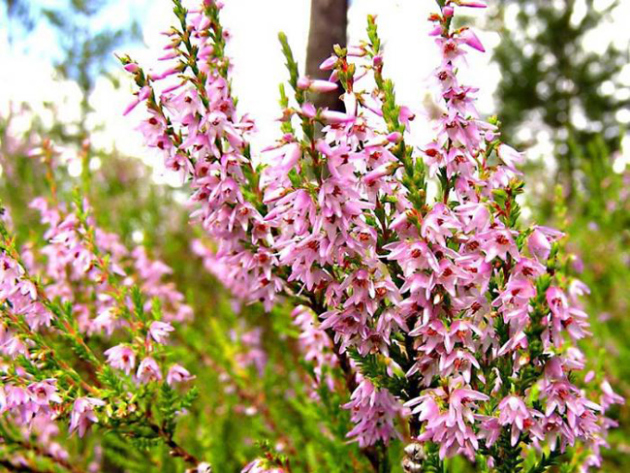
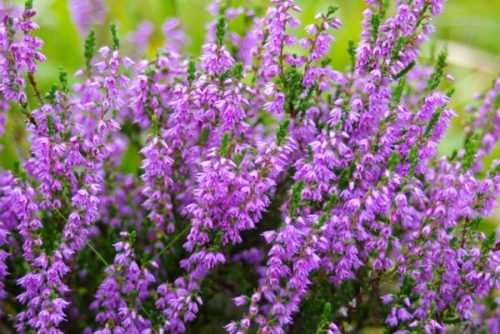
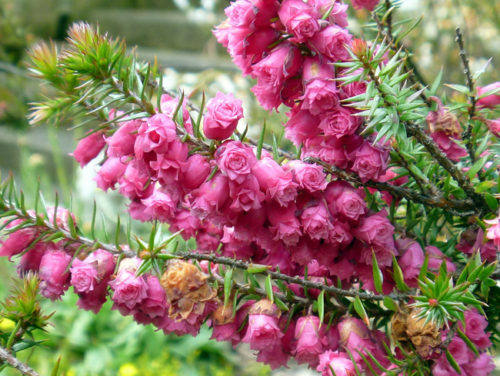
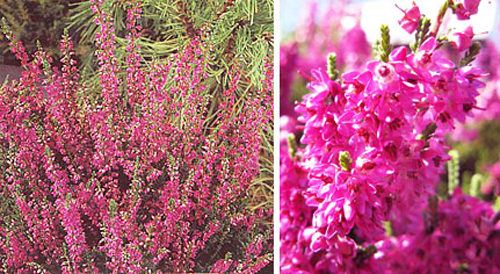
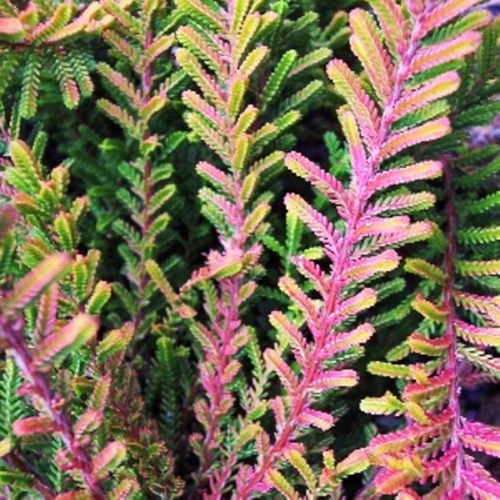

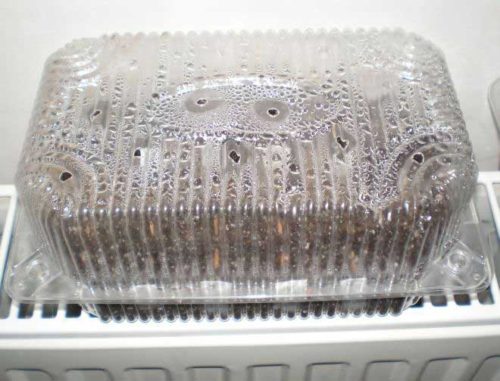
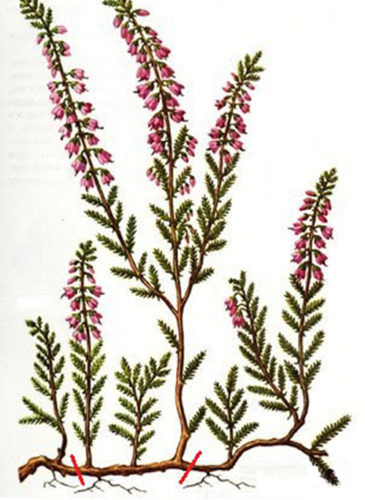
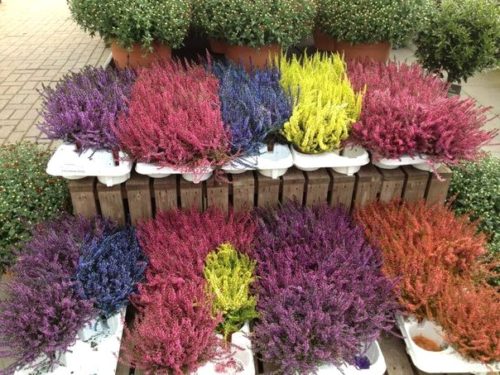
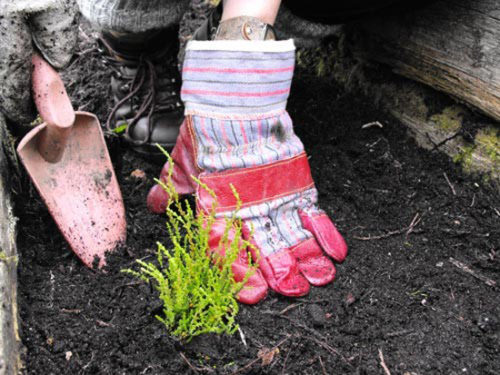

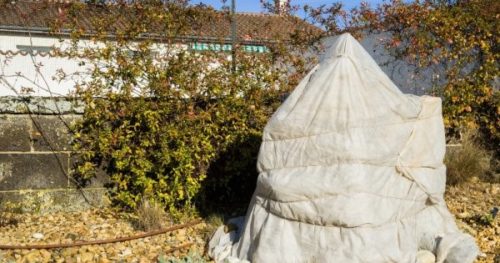
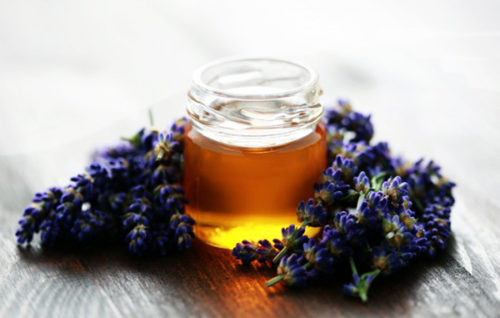

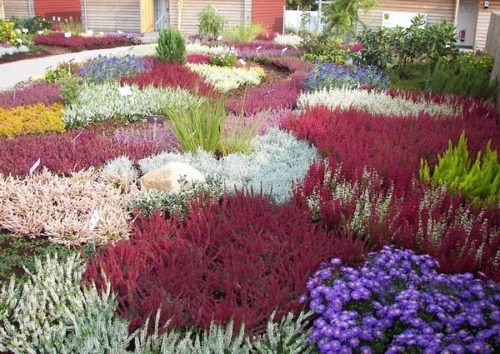
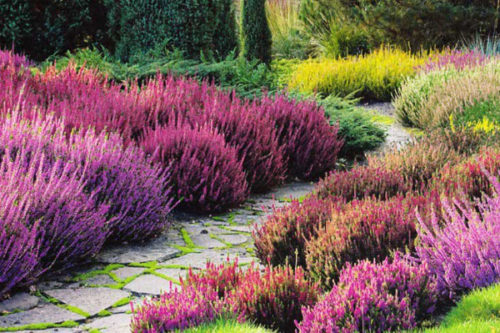












 Start a discussion ...
Start a discussion ...